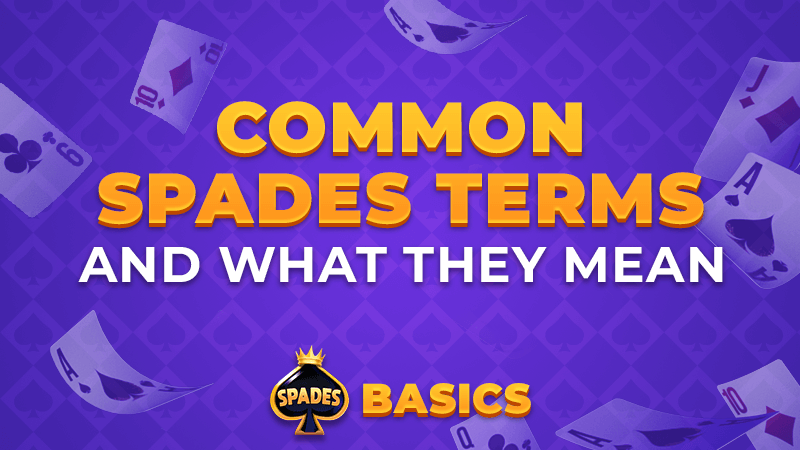Common Spades Terms and What They Mean

In this article, we’ll break down the most commonly used Spades terms, explain what they mean, and provide examples so you can recognize them in action.
1. Basic Game Terms
Trick
A single round of play where each player plays one card. The highest card in the leading suit – or the highest Spade, if Spades are played – wins the trick.
Hand
A full round of play where each player plays all 13 of their cards. A game consists of multiple hands.
Suit
One of the four categories of cards in a deck: Spades (♠), Hearts (♥), Diamonds (♦), and Clubs (♣). Spades is the trump suit in this game.
Trump Suit
The strongest suit in the game. In Spades, this is always Spades. A card from the trump suit beats cards from all other suits in a trick.
2. Bidding Terms
Bid
Your prediction of how many tricks you (or you and your partner) will win in the hand. Players take turns bidding before any cards are played.
Nil
A type of bid where a player commits to winning zero tricks in the hand. Success awards bonus points; failure results in a penalty.
Blind Nil
A high-risk bid where a player commits to Nil before seeing their cards. Usually offers a higher bonus (e.g., 200 points), but comes with greater risk.
Bag (Sandbag)
A trick won beyond your team’s combined bid. For example, if your team bids 5 and wins 7 tricks, you earn 2 bags. These bags accumulate and can result in penalties.
Bag Penalty
When a team accumulates 10 bags, they typically lose 100 points. This discourages players from consistently overbidding.
3. Gameplay Terms
Breaking Spades
Spades cannot be played until they are “broken,” meaning someone has played a Spade because they were out of the led suit. Once broken, Spades can be led in future tricks.
Follow Suit
You must play a card of the same suit that was led in the trick, if you have one. Only if you are void (have none of that suit) can you play a different suit, including Spades.
Cut (or Trump In)
Playing a Spade when you’re out of the led suit in order to try to win the trick. For example, if Clubs are led and you have no Clubs, you might play a Spade to “cut” and win.
Overtrump
Playing a higher Spade than one previously played in the same trick. If two players cut with Spades, the higher one wins.
Undertrump
Playing a lower Spade than one already played in the trick, usually when you don’t want or need to win that trick.
4. Strategy and Scoring Terms
Set
When a team fails to meet their bid, they are said to be “set.” This results in a score penalty (usually -10 points per bid trick).
Books
Another term for “tricks.” Some players refer to tricks as books, particularly in casual games.
Overbid / Underbid
To bid more or fewer tricks than you actually end up taking. Overbidding can lead to a set; underbidding might result in bags.
Reneging
Illegally not following suit when you have a card in the led suit.
5. Teamplay Terms
Partner
In traditional four-player Spades, you play with a teammate seated across from you. You cannot communicate strategy verbally but should coordinate through smart bidding and play.
Signal
An indirect way of “communicating” with your partner through play – such as intentionally losing a trick to avoid interfering with your partner’s strategy. Signaling must follow the rules and never involve spoken hints.
6. Game Progression Terms
Game Point / Match Point
Spades is typically played to a target score, like 500 points. “Game point” refers to being close to reaching the target and possibly winning the match in the next hand.
Short Game / Long Game
Some Spades games are played to a lower score (e.g., 200), making for a “short game.” Others aim for 500 or more, making it a “long game.”
Rubber Spades
A format similar to Rubber Bridge, where teams play a series of games (or “rubbers”) and tally up total points across them. Less common online, but still used in traditional circles.
Want to deepen your understanding of Spades strategy and gameplay? Explore more in our Spades Academy under the “Basics” and “Advanced” categories.

